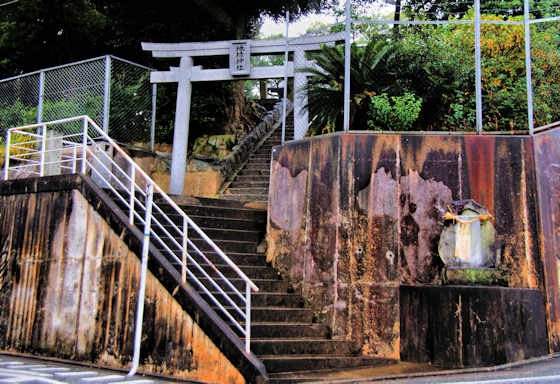Tuesday, February 25, 2014
Izumo 33 Kannon Pilgrimage, Temple 11, Entsuji
Sunday, February 23, 2014
Torii Tunnels
Lines of red torii placed so close together they form a tunnel are a common sight throughout Japan. The most famous and most photographed are at the Fushimi Inari Shrine near Kyoto, but smaller versions can be found all over at shrines and temples.
They are usually made of wood, occasionally steel, but more often nowadays plastic pipe is being used. Each torii will have been paid for by a donation, and the name of the donor is usually written on each, similar to how some shrines will have lines of more expensive stone lanterns.
The top photo is from the Inari Shrine in the grounds of Suwa Shrine, Nagasaki. The second photo is at Tadaji Temple in Hamada. The third is a small Inari hokora near Kokura Castle.
The photo above is an Inari shrine in the grounds of the Hitomaro Shrine in Masuda.
If the Inari shrine is on a hillside, like at Fushimi, then the torii tunnels will switchback up the hillside like the photo above taken at the Taikodani Inari Shrine in Tsuwano.
Thursday, February 13, 2014
Japanese Cormorant
The Japanese Cormorant, Phalacrocorax capillatus, known as Umui in Japanese, is also known as Temmincks Cormorant.
It can be found from Taiwan, across Korea and Japan, and as far north as Eastern Russia.
It has been domesticated by the Japanese to use in fishing. Known as Ukai, it can still be seen at many places across Japan.
The only piece of poetry I remember from my schooldays begins.... "the Common Cormorant, or Shag, lays eggs inside a paper bag. The reason you will see, no doubt, is to keep the lightning out...."
Wednesday, February 12, 2014
Along The Way (Izumo version)
Monday, February 10, 2014
Along the Way
On the afternoon of Sunday, September 4th, 2011, the eighth day of my Shikoku Pilgrimage, I walked the main road west from Temple 21, Tairyuji, towards Temple 22, Byodoji. Early that morning I had left the mountains where I had been trapped by Typoon Talas for a couple of days, took the ropeway up to and down from Tairyuji, and passed through the village of Naka. There were no major sights along the road, but the usual succession of small hokora, roadside shrines, like this one that was guarded by Okinawan style shishi
I climbed up to a largish Hachiman Shrine that, like so many shrines, gave the appearance of being abandoned. I was rewarded by a pair of unusal komainu, something I am always on the look out for. Coming back down to the main road a tiny old lady came out of the door of her house and insisted I sit awhile and drink some cold green tea she offered me.The kindness of strangers. I am not particularly fond of green tea, but it is impolite to refuse Osettai.
You can't walk far in Japan without passing a Jizo, and I must admit I pass many of them by, but a statue of Fudo Myo O, my favorite Buddhist deity, almost always call for a prayer and a photo.
Cresting the pass, the view is, for me anyway, what I would describe as typical Japan.
And then some more small shrines with diverse komainu before encountering what was to be the days most pleasant surprise just before reaching Byodoji.....
Labels:
Fudo Myojin,
henro,
komainu,
tokushima
Saturday, February 8, 2014
Izumo 33 Kannon Pilgrimage Temple 10 Zenjoji
Thursday, February 6, 2014
Chiroku Shrine
Chiroku Shrine
Labels:
haniyasuhime,
izanagi,
komainu,
kyushu108,
Shrine,
takehaniyasuhiko
Tuesday, February 4, 2014
Mitoya Tenmangu
Sunday, February 2, 2014
Shokasonjuku Academy
The Shokasonjuku is located in the grounds of the Shoin Shrine in Hagi, Yamaguchi, and is where Yoshida Shoin taught many of the future leaders of Meiji Japan.
It was originally just a single-roomed structure but was expanded due to the large number of students who wanted to attend. It was also his home as at the time he was under house arrest for his attempt to stow away on an American ship.
Shoin taught here for just one year before he was rearrested and the school forced to close.
His students included Ito Hirobumi, the first Prime Minister of Japan, Yamagata Aritomo, Japan's third Prime Minister, Kido Takayoshi, a senior statesman and another of the architects of the new Meiji state, Inoue Kaoru, another major politician and statesman of Meiji Japan.
Labels:
hagi,
yamaguchi,
yoshida shoin
Subscribe to:
Posts (Atom)





































